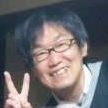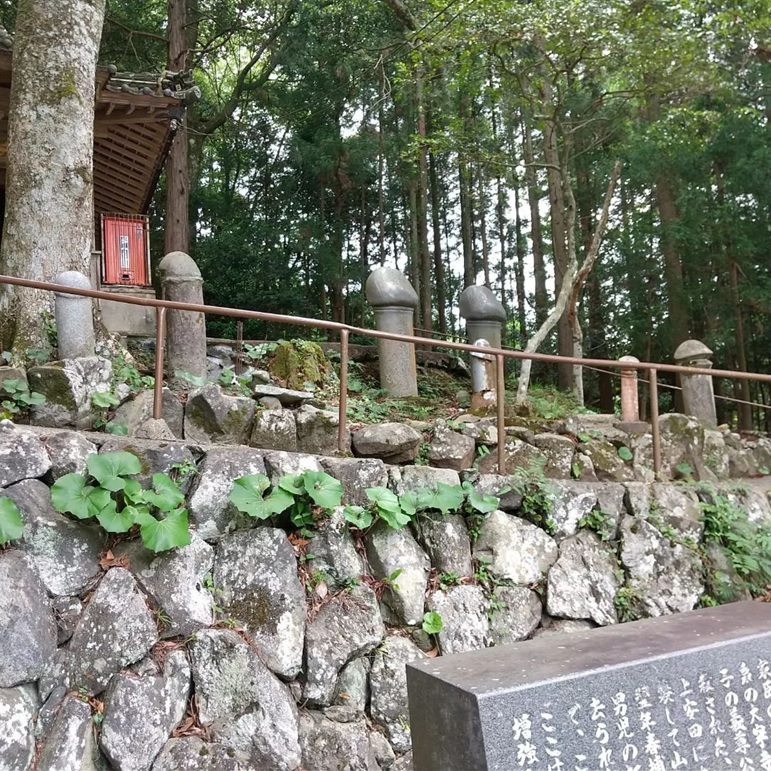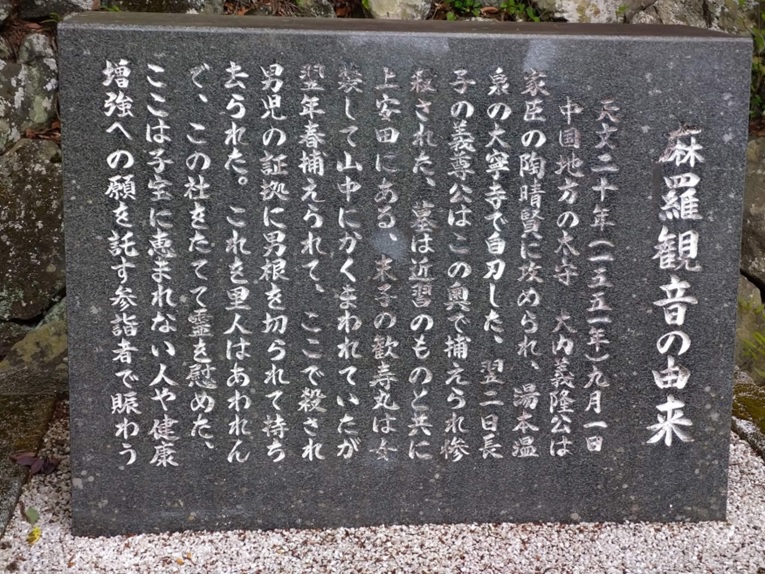


The other day, I went to Hagi for work. On the way, there is "Marakannon" near Tawarayama Onsen. It was along Prefectural Road 281 and I thought it was deep in the mountains, but it was unexpectedly right next to the road.
A symbol of a man standing in the precincts. I felt I want be away from it. Its name is "Marakannon". However, it has a sad history, not just for giving gag and praying for unequaled. Moreover, it has something to do with Suo-Oshima and a little with my Okikamuro Island.
Although it is engraved on the guide plate, 500 years ago, it was the time of Sengoku warlord Ouchi. Yoshioki Ouchi, who occupied the current Chugoku region, was prosperous by force, but his son Yoshitaka was prosperous in culture. It was also Yoshitaka who built the five-storied pagoda Ruriko-ji Temple, a national treasure, in Yamaguchi City. This is the reason why Yamaguchi Prefecture is called "Saikyo" in the west of Kyoto.
Through such an army force gap, his vassal Sue Harukata rebelled and attacked, and Yoshitaka(義隆) suicide. The son, Yoshitaka(義尊), was hiding in a transvestite to pretend to be a girl in order to escape after chasing him. However, he was found and killed by a pursuit, and his genitals were cut off and taken away as a proof of a boy.
The origin is that the villager who felt pity for it worshiped at the place where this incident occurred. That's why it's not a gag that makes you laugh, and when you visit here, you'll feel sadness.
Well, the time is 1555. In the era, Nobunaga Oda moved from the attack on Kiyosu to Kiyosu Castle and took control of the world. After Mr. Ouchi's death, Mouri Motonari, who was also under Mr. Ouchi, raised troops to avenge Sue Harukata. The stage of the battle was "Itsukushima Battle". It is said that this battle changed the power map of Setonaikai 'inland sea'.
The pirates who sided with Mouri were the Mishima Murakami pirates of Noshima, Innoshima, and Kurushima. On the other hand, it was the pirate Ukashima people whose roots were the current Ukashima island of Suo-Oshima. At that time, the pirates were independent and decided where to go each time. At that time, my Okikamuro Island was also under the control of Mr. Ouchi, so the pirate on this island would have been Mr. Kuwahara. That's why it would have been attached to Mouri.
Sue lost this battle, and Suo-Oshima became the territory of the Kurushima pirates in the reward of the battle. There was a castle of Murakami Michiyasu (Kurushima) at the top of Mt. Togo in Kuka. After this battle, the Murakami pirates will take control of the sea in Setouchi. In the first Kizugawa battle, he became Japan's strongest pirates as the Mouri Navy until he defeated Nobunaga's army.
By the way, the era of time is the era of Toyotomi. In 1588, Hideyoshi issued a pirate ban, which could be called a sea sword hunt. This prohibits piracy and many pirates leave the island. This Okikamuro will also become an uninhabited island, and pirates will land. The place name Pirate Ura still remains on the island, and Mr. Kuwahara may have been pirated there. It is probably the descendants of Kuwahara who have many surnames in the area on the opposite bank.
After that, the Battle of Sekigahara took place in 1600 due to the battle for Toyotomi's traces. Mouri is attached to Ishida Mitsunari's side, and Tokugawa squeezes him into two districts. At this time, Kurushima Murakami, who had Suo-Oshima as his territory, was attached to the Tokugawa clan, so he leaved Mouri side and Mishima Murakami split. After that, Kurushima Murakami ‘来島村上’ named himself Kurushima ‘久留島’ and was given a territory to the present Bungo Province in Oita Prefecture and became the lord of the Mori.
However, an accident occurs. In 1663, Michikata, the son of the feudal lord Micharu, ran into the reef of Seto in the Okikamuro, which he passed by due to a change of attendance for Edo, and all 11 people died. There is a lighthouse under the Okikamuro Bridge, where is a reef. The tomb of the pirates at Fumonji Temple on the hillside of Mt. Takeyama. It is a pity that he will die in this land that he once owned Suo-Oshima.
The story goes back and forth, but after the Battle of Sekigahara, Iyo's Sengoku daimyo Kono was also destroyed. In 1606, his vassal, Mr. Ishizaki, started to live in Okikamuro which had become an uninhabited island due to the ban on pirates. Five years earlier, in 1601, Nosima Murakami Takeyoshi a former admiral of the Murakami pirates, moved to Wada in the former Towa town of Suo-Oshima. Since he was under the same Kono clan, I personally speculate that Takeyoshi might have invited him to come here because the Okikamuro is vacant.
Mr. Ishizaki was picked up by a samurai, and later the branch family called himself Tomozawa. The Mouri clan gave a plot of Ukashima which were once the roots of the pirate Ukashima people, Munasejima, and Mitsumatsu Agenosho, as territories and embarked on development. By the way, Ukashima island means a floating island that no one owns.
However, the development of the Tomozawa family's Ukashima island seems to have been difficult. The people of Mori village on the opposite bank used it as a firewood mountain for grilling salt, and there was a constant dispute over ownership. Although it is within reach of Mori village on the opposite bank, he belonged to Agenosho because he hated the conflict.
Agenosho Mimatsu where Tomozawa family was given by the Mouri clan, was returned to the clan when the Taisei Hokan was occurred. The land on the Ukashima island seems to have returned around that time. Regarding the land of Ominase Island, I ordered the official map of the island when I helped Professor Nagashima, the chairman of the Japan Society of Island Studies, to conduct a folk survey. The drawings spread enough to fill the room on the second floor of Tainosato. The registered domicile of the Ishizaki family is still on Ominase Island. I heard from the owner who has already died that the lot number of his registered domicile is not in Okikamuro Island and when he contacted the government office, it was Ominase Island. When I wondered where the No. 1 of Okikamuro address was, it was the well of the Ishizaki family.
Returning to the story of Sue, there is still a district called ‘Sue’ in Yamaguchi City. The surname of Sue Harukata also comes from there. Also, as an aside, it was the Matsumoto family who applied for the national settlement policy and cultivated the Sue area after the war. It was a wasteland in the mountains. My cousin still lives in the land.


Shoji Matsumoto